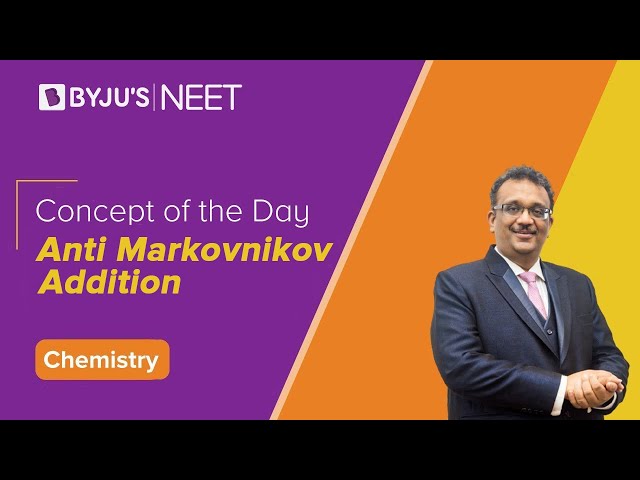Markovnikov’s Rule, also known as Markownikoff’s rule, can be used to describe the outcome of some chemical addition reactions. The Russian chemist Vladimir Vasilyevich Markovnikov first formulated this rule in 1865.
What is Markovnikov’s Rule?
When a protic acid (HX) is added to an asymmetric alkene, the acidic hydrogen attaches itself to the carbon having a greater number of hydrogen substituents whereas the halide group attaches itself to the carbon atom which has a greater number of alkyl substituents.
To simplify the rule, it can also be stated as – “Hydrogen is added to the carbon with the most hydrogens and the halide is added to the carbon with the least hydrogens”.
An example of a reaction that observes Markovnikov’s rule is the addition of hydrobromic acid (HBr) to propene, which is shown below.

It can be observed from the reaction illustrated above that the majority of the products formed obey Markovnikov’s rule, whereas the minority of the products do not.
Let us consider the addition reaction wherein an alkene reacts with water to give rise to alcohol. This reaction proceeds via the formation of a carbocation. It is observed in this reaction that the hydroxyl group attaches itself to the carbon with more carbon-carbon bonds whereas the hydrogen atom attaches itself to the other carbon in the double bond, which has more carbon-hydrogen bonds.
What is the Mechanism Behind Markovnikov’s Rule?
To understand this mechanism, let us consider the same example illustrated earlier, i.e. the addition reaction of hydrobromic acid with propene. The Mechanism of Markovnikov’s rule can be broken down into the following two steps.
Step 1
The alkene is protonated and it gives rise to the more stable carbocation as shown below.

From the illustration shown above, we can see that there are two types of carbocations that can be formed from the protonation of the alkene, one is a primary carbocation and the other is a secondary carbocation. However, the secondary carbocation is far more stable and therefore, its formation is preferred over the formation of a primary carbocation.
Step 2
The halide ion nucleophile now attacks the carbocation. This reaction yields the alkyl halide. Since the formation of the secondary carbocation is preferred, the major product of this reaction would be 2-bromopropane as illustrated below.

It is important to note that Markovnikov’s rule was developed specifically for its application in the addition reaction of hydrogen halides to alkenes. The opposite of ‘Markovnikov’ addition reactions can be described as Anti-Markovnikov based on the regioselectivity of the reaction.
Examples of Markovnikov and Anti-Marknovnikov Addition Reactions
The Hydration of Alkenes
When alkenes are treated with certain aqueous acids (usually sulfuric acid), the resulting electrophilic addition reaction yields an alcohol as the product. The regioselectivity of such reactions can be predicted by Markownikoff’s rule. Therefore, these reactions can be classified as Markovnikov reactions. In the hydration of alkenes, the H+ ion acts as an electrophile and attacks the alkene to generate a carbocation intermediate (the intermediate with greater stability is protonated). The subsequent nucleophilic attack on the carbocation by water molecules forms an oxonium ion, which is deprotonated to afford the required alcohol product.
The Hydroboration/Oxidation of Alkenes
When alkenes are treated with borane (BH3) in the presence of hydrogen peroxide or sodium hydroxide, an alcohol is obtained as the final product. In this electrophilic addition reaction, the boron atom acts as an electrophile. This reaction does not obey Markovnikov’s rule and can, therefore, be classified as an anti-Markovnikov reaction.
Recommended Videos
Anti-Markovnikov Addition Video Lesson

Frequently Asked Questions – FAQs
What is the reasoning behind Markovnikov’s Rule?
Does the following reaction obey Markovnikov’s Rule?
If the following reaction obeys Markovnikov’s Rule, what would be the Major Product?
What does Markovnikov’s rule predict?
Which reactions do not obey Markovnikov’s rule?
What is markovnikov’s rule?
Name a reaction that follows markovnikov’s rule?
Why does Markovnikov’s rule work?
What is the peroxide effect?
Name a compound that does not follow Markovnikov’s rule?
To learn more about this concept and other concepts related to addition reactions, register with BYJU’S and download the mobile application on your smartphone.

Thanks…
i am satisfied with this explanation,thank you.
very helpful
Very very helpful
At last you had cleared my doubts completely. Thank you very much.